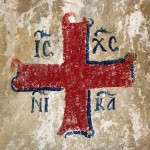Created by: Silentchapel
Number of Blossarys: 95
Orans, a loanword from Medieval Latin translated as one who is praying or pleading, also Orant or Orante, is a figure in art with extended arms or bodily attitude of prayer, usually standing, with ...
The labarum (Greek: λάβαρον) was a vexillum (military standard) that displayed the "Chi-Rho" symbol ☧, formed from the first two Greek letters of the word "Christ" (Greek: ...
An icon case or kiot is a decorated case (usually foldable) or glass shelf for keeping and displaying religious icons. Icon cases range in size and design. Common Greek kiots are tall and typically ...
The Hetoimasia, Etimasia (Greek ἑτοιμασία, "preparation"), prepared throne, Preparation of the Throne, ready throne or Throne of the Second Coming is the Christian version of the symbolic ...
Hellmouth is the entrance to Hell envisaged as the gaping mouth of a huge monster, an image which first appears in Anglo-Saxon art, and then spread all over Europe, remaining very common in ...
Hell icons (Russian: Адописная икона, Adopisnaya ikona, lit. "Hell-written icon" or "of a Hell descent icon") are legendary icons with images of Devil hidden under primer, riza or ...
The Hand of God, or Manus Dei in Latin, also known as Dextera domini/dei, the "right hand of God", is a motif in Jewish and Christian art, especially of the Late Antique and Early Medieval ...


 English (EN)
English (EN) 





